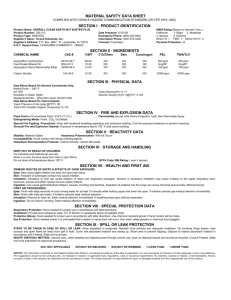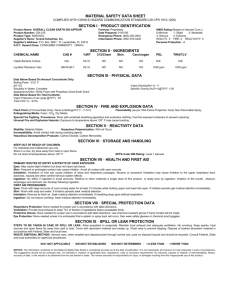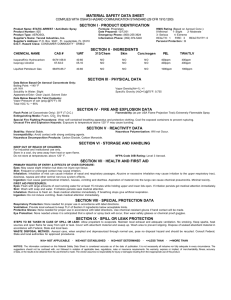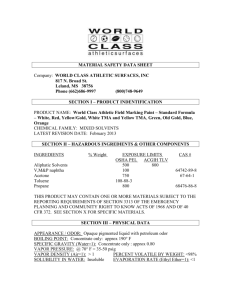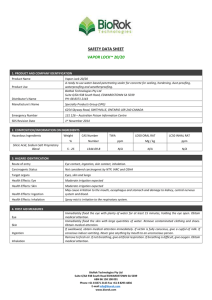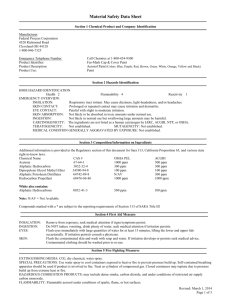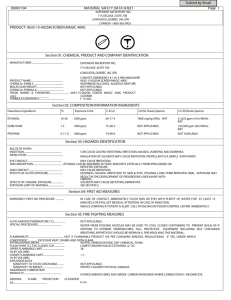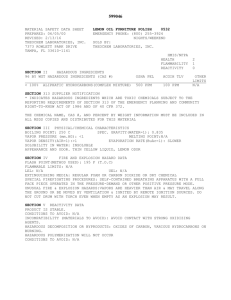aceboltbuster.msds
advertisement
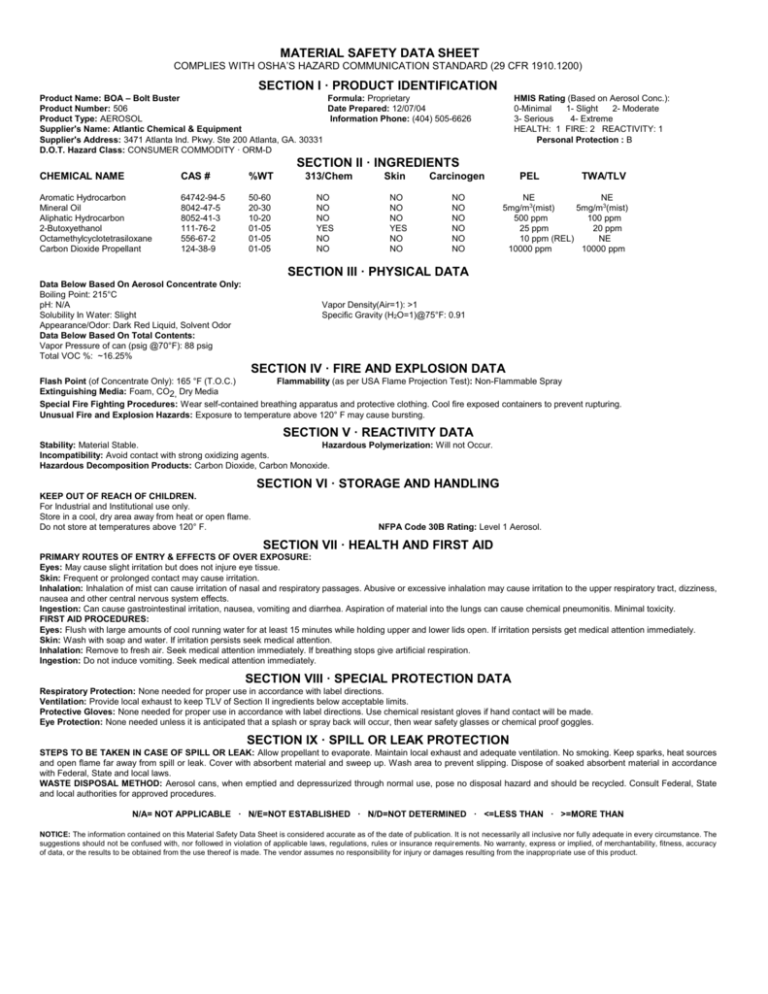
MATERIAL SAFETY DATA SHEET COMPLIES WITH OSHA’S HAZARD COMMUNICATION STANDARD (29 CFR 1910.1200) SECTION I · PRODUCT IDENTIFICATION Product Name: BOA – Bolt Buster Formula: Proprietary Product Number: 506 Date Prepared: 12/07/04 Product Type: AEROSOL Information Phone: (404) 505-6626 Supplier's Name: Atlantic Chemical & Equipment Supplier's Address: 3471 Atlanta Ind. Pkwy. Ste 200 Atlanta, GA. 30331 D.O.T. Hazard Class: CONSUMER COMMODITY · ORM-D HMIS Rating (Based on Aerosol Conc.): 0-Minimal 1- Slight 2- Moderate 3- Serious 4- Extreme HEALTH: 1 FIRE: 2 REACTIVITY: 1 Personal Protection : B SECTION II · INGREDIENTS CHEMICAL NAME CAS # %WT Aromatic Hydrocarbon Mineral Oil Aliphatic Hydrocarbon 2-Butoxyethanol Octamethylcyclotetrasiloxane Carbon Dioxide Propellant 64742-94-5 8042-47-5 8052-41-3 111-76-2 556-67-2 124-38-9 50-60 20-30 10-20 01-05 01-05 01-05 313/Chem NO NO NO YES NO NO Skin NO NO NO YES NO NO Carcinogen NO NO NO NO NO NO PEL TWA/TLV NE NE 5mg/m3(mist) 5mg/m3(mist) 500 ppm 100 ppm 25 ppm 20 ppm 10 ppm (REL) NE 10000 ppm 10000 ppm SECTION III · PHYSICAL DATA Data Below Based On Aerosol Concentrate Only: Boiling Point: 215°C pH: N/A Solubility In Water: Slight Appearance/Odor: Dark Red Liquid, Solvent Odor Data Below Based On Total Contents: Vapor Pressure of can (psig @70°F): 88 psig Total VOC %: ~16.25% Vapor Density(Air=1): >1 Specific Gravity (H2O=1)@75°F: 0.91 SECTION IV · FIRE AND EXPLOSION DATA Flash Point (of Concentrate Only): 165 °F (T.O.C.) Flammability (as per USA Flame Projection Test): Non-Flammable Spray Extinguishing Media: Foam, CO2, Dry Media Special Fire Fighting Procedures: Wear self-contained breathing apparatus and protective clothing. Cool fire exposed containers to prevent rupturing. Unusual Fire and Explosion Hazards: Exposure to temperature above 120° F may cause bursting. SECTION V · REACTIVITY DATA Stability: Material Stable. Hazardous Polymerization: Will not Occur. Incompatibility: Avoid contact with strong oxidizing agents. Hazardous Decomposition Products: Carbon Dioxide, Carbon Monoxide. SECTION VI · STORAGE AND HANDLING KEEP OUT OF REACH OF CHILDREN. For Industrial and Institutional use only. Store in a cool, dry area away from heat or open flame. Do not store at temperatures above 120° F. NFPA Code 30B Rating: Level 1 Aerosol. SECTION VII · HEALTH AND FIRST AID PRIMARY ROUTES OF ENTRY & EFFECTS OF OVER EXPOSURE: Eyes: May cause slight irritation but does not injure eye tissue. Skin: Frequent or prolonged contact may cause irritation. Inhalation: Inhalation of mist can cause irritation of nasal and respiratory passages. Abusive or excessive inhalation may cause irritation to the upper respiratory tract, dizziness, nausea and other central nervous system effects. Ingestion: Can cause gastrointestinal irritation, nausea, vomiting and diarrhea. Aspiration of material into the lungs can cause chemical pneumonitis. Minimal toxicity. FIRST AID PROCEDURES: Eyes: Flush with large amounts of cool running water for at least 15 minutes while holding upper and lower lids open. If irritation persists get medical attention immediately. Skin: Wash with soap and water. If irritation persists seek medical attention. Inhalation: Remove to fresh air. Seek medical attention immediately. If breathing stops give artificial respiration. Ingestion: Do not induce vomiting. Seek medical attention immediately. SECTION VIII · SPECIAL PROTECTION DATA Respiratory Protection: None needed for proper use in accordance with label directions. Ventilation: Provide local exhaust to keep TLV of Section II ingredients below acceptable limits. Protective Gloves: None needed for proper use in accordance with label directions. Use chemical resistant gloves if hand contact will be made. Eye Protection: None needed unless it is anticipated that a splash or spray back will occur, then wear safety glasses or chemical proof goggles. SECTION IX · SPILL OR LEAK PROTECTION STEPS TO BE TAKEN IN CASE OF SPILL OR LEAK: Allow propellant to evaporate. Maintain local exhaust and adequate ventilation. No smoking. Keep sparks, heat sources and open flame far away from spill or leak. Cover with absorbent material and sweep up. Wash area to prevent slipping. Dispose of soaked absorbent material in accordance with Federal, State and local laws. WASTE DISPOSAL METHOD: Aerosol cans, when emptied and depressurized through normal use, pose no disposal hazard and should be recycled. Consult Federal, State and local authorities for approved procedures. N/A= NOT APPLICABLE · N/E=NOT ESTABLISHED · N/D=NOT DETERMINED · <=LESS THAN · >=MORE THAN NOTICE: The information contained on this Material Safety Data Sheet is considered accurate as of the date of publication. It is not necessarily all inclusive nor fully adequate in every circumstance. The suggestions should not be confused with, nor followed in violation of applicable laws, regulations, rules or insurance requir ements. No warranty, express or implied, of merchantability, fitness, accuracy of data, or the results to be obtained from the use thereof is made. The vendor assumes no responsibility for injury or damages resulting from the inappropriate use of this product.
